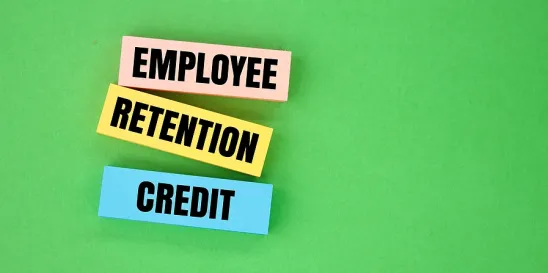On December 21, 2023, the Internal Revenue Service (“IRS”) announced (IR-2023-247) a voluntary disclosure program (“VDP”) for employers that received questionable employee retention tax credits (“ERTC”). Specifically, this new VDP seeks to assist these employers while providing them with an opportunity to voluntarily repay only eighty percent (80%) of the ERTC received and potentially avoid both penalties and interest, while being allowed to keep twenty percent (20%) of the ERTC received. The IRS has been clear that they are concerned about fraudulent or inaccurate ERTC claims prepared by so-called “ERTC mills” and they will be aggressively auditing these claims. If you used one of these ERTC mills, this program may be particularly attractive to you. One concern we have identified are claims that used a partial suspension of operations due to a government order that included all of the second quarter and/or third quarter of 2021 after many state government orders expired. Also, claims relying solely on OSHA guidance or on supply chain delays may be at a heightened risk and this VDP program should be considered.
ERTC Voluntary Disclosure Program Overview
At its core, the VDP represents a crucial component of the IRS's broader strategy to curb deceptive marketing practices related to ERTC claims. The program primarily functions as a safety net for employers that became entangled in the complexities of ERTC filing and/or deceptive marketing, offering them a transparent pathway to rectify their errors and contribute to a fair and compliant tax environment. The deadline to apply for entry into the VDP is March 22, 2024.
Eligibility Criteria and Application Process
Any employer that has received the ERTC can participate in the VDP for each tax period, so long as the employer satisfies the following requirements:
- Employer Received ERTC: The ERTC claim(s) must have been processed and paid, either as a refund, credit, or deposit, on specified IRS forms.
- Belief of No Eligibility: Employers must believe that they are entitled to zero ($0) ERTC for each tax period in order to be eligible for the VDP.
- No Ongoing IRS Examination: The employer cannot be under an IRS employment tax examination for any period covered by the VDP submission.
- No Notice and Demand for Repayment: The IRS has not reversed or notified the employer of its intent to reverse the employer’s ERTC to zero ($0).
- Employer Reversal: Employers that have already reversed/withdrawn their ERTC to zero ($0) are (generally) not eligible.
- Non-compliance Information: The IRS has not received information directly or from a third-party indicating the employer is noncompliant with its ERTC obligations.
Further, employers need to be aware that applications that include tax periods ending in 2020 must also complete and submit a Form SS-10, Consent to Extend the Time to Assess Employment Taxes, which effectively extends the statute of limitations on assessments to April 15, 2025.To initiate the process, employers must submit Form 15434, Application for Employee Retention Credit Voluntary Disclosure Program, using the dedicated portal on the IRS’s website. The employer must include, among other things, the name, address and phone number of any preparer or advisor that was involved with the ERTC. Employers outsourcing payroll obligations to a third-party must ensure that the third-party files the necessary form.
Repayment and Installment Agreements
A distinctive feature of the program is the emphasis on the repayment of only eighty percent (80%) of the ERTC claim received rather than the full credit. For example, if an employer received a total of $100,000 in non-refundable and refundable ERTC, under the VDP terms, the employer would have to repay only $80,000 ($100,000 - $20,000 reduction). This reduced repayment figure is designed to accommodate businesses that may have been deceived by promoters charging excessive fees, which were often contingent on the amount of the credit. One of the most significant benefits of the VDP is that employers do not need to amend their income tax returns to report the twenty percent (20%) of the ERTC that they do not have to repay under the VDP. If the employer had received interest on the ERTC refund claim from the IRS, this interest does not need to be repaid or reported as income, either. In addition, the employer does not need to modify its wage expense related to the twenty percent (20%) of the ERTC that is not repaid. If accepted into the program, the employer will need to enter into a closing agreement with the IRS to finalize the VDP.
For those employers unable to make the full repayment at the time of the closing agreement, the IRS may consider installment agreements on a case-by-case basis, contingent upon the submission of Form 433-B, Collection Information Statement for Businesses, and all necessary documentation. However, under the IRS’s standard installment agreement policy, penalties and interest will apply, so employers who cannot repay 80% of the ERTC amount upon signing the closing agreement may consider other options, such as obtaining a loan from a financial institution, to avoid the costs of an installment agreement with the IRS.
Further, the IRS is still actively encouraging employers with pending ERTC claims to consider the withdrawal program it announced in October 2023, which enables employers to remove their pending ERTC claims without incurring interest or penalties.
The IRS is Aggressively Pursuing ERTC Claims
In July 2023, the IRS heightened its scrutiny of ERTCs claims, intensified audits and launched criminal investigations targeting promoters and businesses associated with dubious claims. To address concerns about aggressive ERTC marketing, the IRS implemented a moratorium on processing new ERTC claims starting on September 14, 2023. Emphasizing the importance of compliance, enhanced reviews of existing claims submitted before the moratorium were initiated, aiming to curb fraud and shield businesses from potential penalties or interest arising from questionable claims promoted by ERTC marketers. In December 2023, the IRS distributed of over 20,000 letters to employers, disallowing their ERTC claims based on factors such as nonexistent businesses or a lack of eligible employees. Additionally, the IRS announced the initiation of letters proposing tax adjustments for up to 20,000 additions employers who had claimed erroneous or excessive ERTC amounts. Ongoing efforts involve the expansion of IRS audits and criminal investigation work targeting dubious ERTC claims, with over 300 criminal cases and claims valued at nearly $3 billion under investigation as of December 2023.
In guidance released by the IRS explaining its VDP program, the IRS noted that employers who do not utilize the VDP or that are found ineligible, will be subject to a whole host of civil penalties (and interest) including: (1) failure-to-pay; (2) failure-to-file; (3) failure-to-deposit; (4) accuracy related penalties; (5) civil fraud penalties; (6) fraudulent failure-to-file penalties combined with the failure-to-file penalties; and (7) trust fund recovery penalties.
Criminal charges related to the ERTC can include, but are not limited to: (1) tax evasion; (2) filing a false return; (3) false claims; and (4) false statements. Note that employers that willfully filed an employment tax return that fraudulently claimed an ERTC will not be protected from potential criminal investigation and prosecution by pursuing the VDP.
Conclusion
The VDP is an opportunity for ineligible businesses to correct errors related to ERTCs. By following the prescribed procedures, businesses cannot only correct their records but also benefit from only needing to repay 80% of the ERTC received. As businesses navigate the complexities of ERTC compliance, the VDP stands as a new tool in promoting tax transparency and compliance. Employers are encouraged to reach out to Polsinelli or other tax professionals to make sure they are taking the appropriate steps in evaluating whether the VDP, or other ERTC programs, make sense in for their particular facts and circumstances. Polsinelli has extensive expertise in this area and can help answer any questions that employers may have.






 />i
/>i

